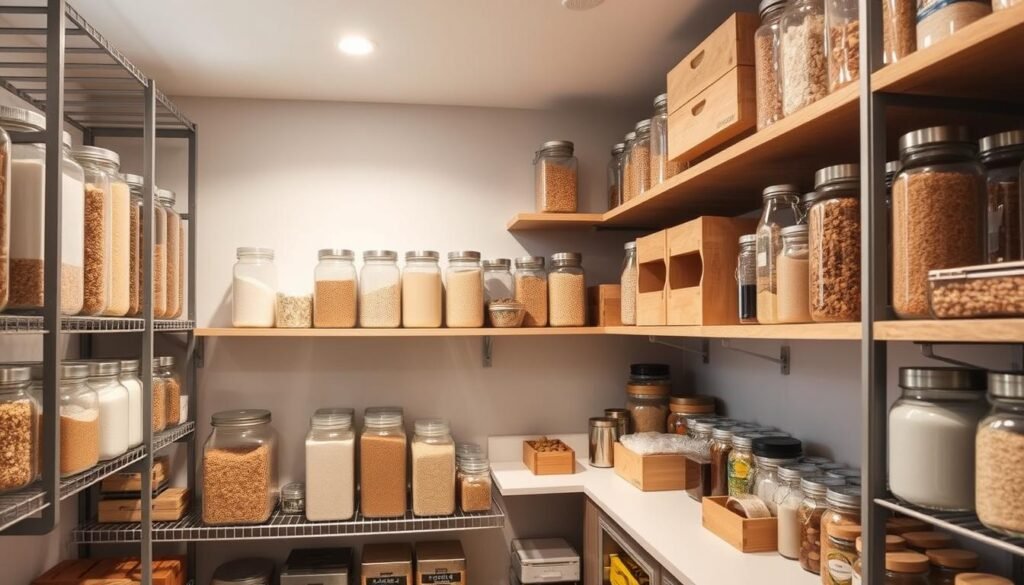
Are you tired of rummaging through a cluttered kitchen to find what you need? You’re not alone! A chaotic pantry can be frustrating and stressful.
A well-organized storage space isn’t just visually appealing – it’s a game-changer for your entire kitchen workflow. It can save you time, money, and stress, making cooking and meal prep significantly easier.
In this comprehensive guide, we’ll explore practical organization ideas to transform your cluttered space into a functional and efficient area that works for your lifestyle.
Key Takeaways
- Discover simple changes to reduce food waste and streamline grocery shopping
- Learn how to create a functional kitchen space that works for you
- Explore practical storage solutions for kitchens of all sizes
- Transform your cluttered pantry into an organized system
- Save time, money, and stress with a well-organized kitchen
The Pantry Problem: Why Organization Matters

Pantry organization is key to a stress-free kitchen experience. A well-organized pantry is the backbone of a clutter-free kitchen, allowing you to optimize your kitchen layout by consolidating everything in one location.
Consider the frustration of buying duplicate ingredients because you couldn’t find what you already had buried in your pantry. This common issue not only wastes money but also precious kitchen space. As Laura Smith, a professional organizer, notes, “A disorganized pantry creates daily stress, turning meal preparation into a frustrating treasure hunt.”
A disorganized pantry can lead to wasted time and food. The average person spends 2.5 days per year looking for misplaced items. By organizing your pantry, you’ll save time and reduce food waste, contributing to a calmer kitchen environment.
An organized pantry can actually inspire you to cook more often. When pantry items are visible and accessible, you’re more likely to use what you have before it expires, saving you money in the process.
Assessing Your Pantry Space: Finding the Right Solutions

To maximize your pantry’s efficiency, you first need to understand its limitations and capabilities. Assessing your pantry space is the first step towards creating a functional storage system.
Let’s explore how different types of pantries can be optimized for your kitchen’s needs.
Walk-In Pantry Potential
A walk-in pantry offers ample storage opportunities. You can install shelves, baskets, and drawers to keep your items organized and easily accessible. Consider using the walls for additional storage with hooks or a pegboard.
Cabinet Pantry Possibilities
If you lack a traditional pantry, utilize cabinet storage instead. Vertical cabinet doors can conceal deep drawers that hold all your pantry staples. Here are some strategies to make the most of your cabinet pantry:
- Use pull-out drawers and sliding shelves to eliminate the frustration of items getting lost in the back.
- Consider door-mounted storage systems to maximize every inch of available space in your kitchen.
- Uniform containers that stack efficiently can double the capacity of your cabinet pantry.
Essential Home Pantry Solutions for Any Space
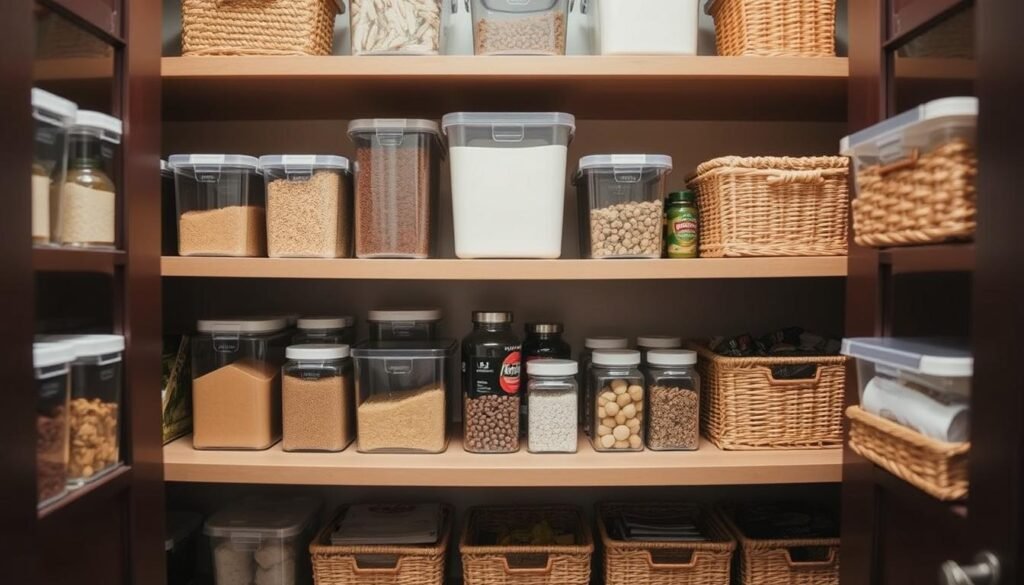
A clutter-free pantry is within reach when you have the essential home pantry solutions. To start, you’ll need to assess your pantry’s specific needs and choose the right organizational tools.
Clear Containers and Canisters
Clear containers and canisters are a great way to store dry goods like pasta, rice, and snacks. They keep your pantry items fresh and visible, making it easy to find what you need.
Basket and Bin Systems
Baskets and bins are versatile storage solutions for your pantry. They come in various styles, from woven baskets to plastic bins, and can be used to store everything from canned goods to napkins.
- Baskets and bins create instant organization by corralling similar items together, preventing the scattered look that makes pantries feel cluttered.
- Opt for open-top designs for frequently accessed items and lidded options for seasonal or occasional use products.
- Label your bins and baskets clearly so everyone in the household knows exactly where items belong and where to find them.
- Consider clear plastic bins for packaged snacks and kid-friendly items, making it easy for little ones to see and select their own snacks.
- Stackable bins maximize vertical space while creating distinct zones for different categories of pantry items.
Maximizing Door Space: The Forgotten Storage Zone
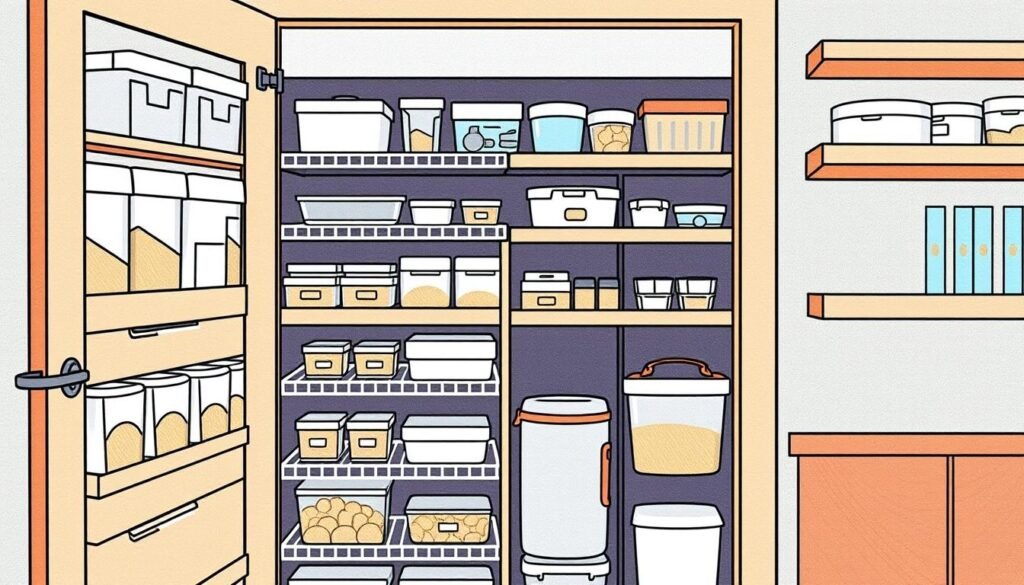
The back of your pantry door is a treasure trove of untapped storage potential. By installing shallow shelves on the door, you can maximize storage in a tight pantry space. These shelves are ideal for grab-and-go items like snack pouches, individual drink bottles, and single-serve products.
Here are a few strategies to make the most of your pantry door:
- The back of your pantry door offers valuable real estate that’s often overlooked but can add significant storage capacity to your pantry.
- Door-mounted racks are perfect for storing spices, condiments, and other small items that would otherwise get lost on deep shelves.
- Consider adjustable door systems that can be reconfigured as your storage needs change over time.
- Look for door organizers with varying pocket sizes to accommodate different types of pantry items.
- When installing door storage, ensure there’s adequate clearance for the door to close properly once the organizers are filled with products.
By utilizing your pantry door effectively, you can create a more organized and functional kitchen space. It’s all about making the most of the space you have available.
Pull-Out Shelving: Access Everything with Ease

Pull-out shelving is a game-changer for deep pantries and cabinets. It eliminates the frustration of items getting lost in the back of deep shelves, making everything accessible with a simple slide.
These systems can be retrofitted into existing pantry spaces or cabinets without requiring a complete renovation of your kitchen. Consider full-extension slides that allow the entire shelf to come out, providing complete visibility and easy access to everything stored there.
Pull-out shelving works particularly well for heavy items like canned goods, appliances, and bulk ingredients that would be difficult to reach in standard shelving. When installing pull-out shelving, group similar items together on each shelf to create intuitive zones that make finding what you need quick and easy.
Drawer Dividers: Creating Order from Chaos
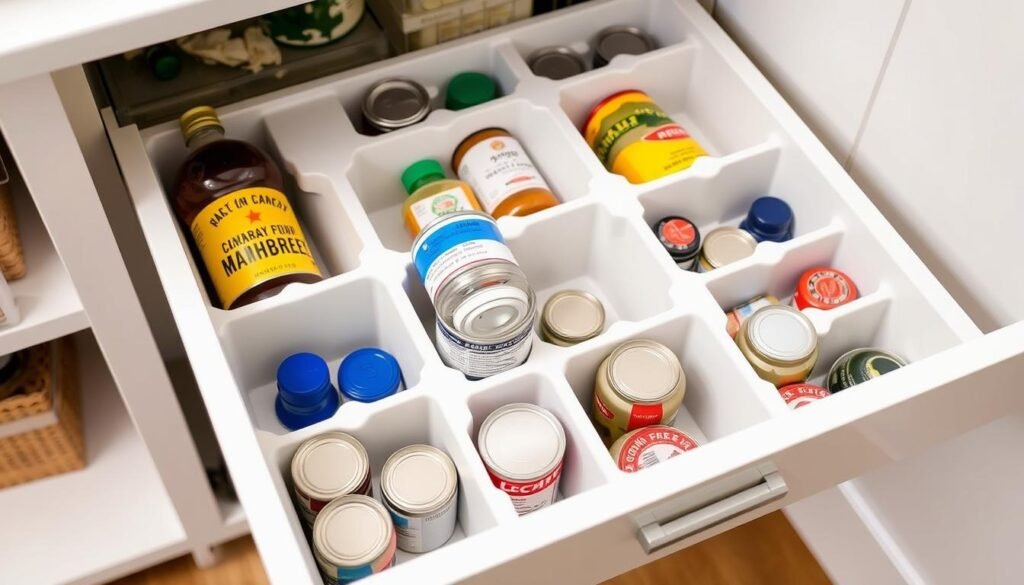
Drawer dividers are a simple yet effective solution for pantry organization. To help prevent bottles, cans, and other items from toppling over whenever you pull out the drawer, use drawer organizers to hold them in place.
Heidi Piron Design and Cabinetry installed flexible dividers here to keep liquor bottles from clanking together, but these separators work for everything from food storage containers to cutting boards, enhancing overall organization in your pantry or cabinets.
The benefits of using drawer dividers include:
- Drawer dividers transform chaotic catch-all drawers into organized, functional spaces where everything has its place.
- Adjustable dividers offer flexibility to accommodate items of different sizes and can be reconfigured as your storage needs change.
- Consider using dividers to create designated sections for different categories of things—baking tools in one section, measuring cups in another.
- Drawer dividers are particularly useful for small, loose items that tend to get jumbled together, like spice packets, tea bags, or snack bars.
- When organizing drawers, place frequently used items toward the front and occasional-use items toward the back for maximum efficiency, making it a great idea for your kitchen.
Vertical Storage Solutions: Using Your Wall Space
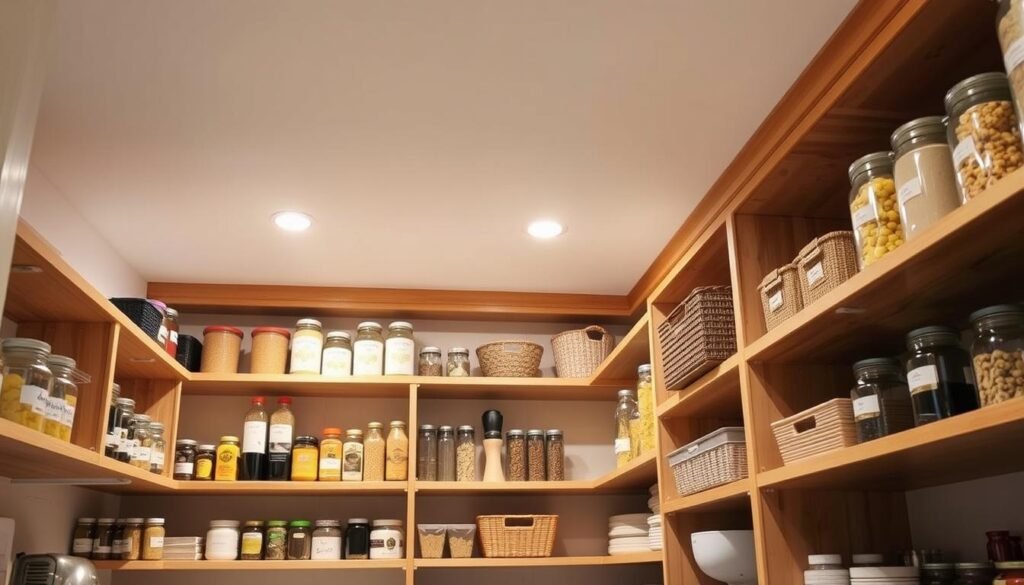
Maximizing your pantry’s vertical space can be a game-changer for kitchen organization. By utilizing the area from floor to ceiling, you can significantly increase your storage capacity.
Ceiling-to-Floor Shelving
Stretching cabinetry all the way to the ceiling is an effective way to make the most of your pantry’s vertical space, as seen in designs by Caren Rideau. This approach not only provides ample storage but also draws the eye upward, creating a sense of height.
Library Ladders for Tall Pantries
A library ladder is both stylish and functional, providing safe and easy access to upper shelves. These ladders come with locking mechanisms for safety and can be designed to slide along a track, making them a practical solution for tall pantries.
| Solution | Benefits |
|---|---|
| Ceiling-to-Floor Shelving | Increased storage, visually appealing |
| Library Ladders | Safe access to upper shelves, stylish |
By incorporating these vertical storage solutions into your pantry design, you can create a highly functional and organized space that makes the most of your kitchen’s storage potential.
Categorizing Your Pantry: Zones for Efficiency

Imagine having a pantry where everything has its place – categorizing into zones makes this possible. By dividing your pantry into specific areas, you can significantly enhance its functionality and your overall efficiency in the kitchen.
Designate specific shelves or sections for different categories such as breakfast foods, snacks, beverages, dinner ingredients, and extra paper products. Using bins and baskets can help keep items organized within these zones. Labels are crucial as they define the zones, making it clear where to find things and where to put items away.
Breakfast Station
A dedicated breakfast zone can include cereals, oatmeal, and breakfast bars, making mornings easier.
Baking Zone
Keep all your baking supplies, such as flour, sugar, and baking powder, in one area for efficient meal preparation.
Snack Area
A designated snack zone makes healthy options visible and accessible. Use clear bins or baskets at an appropriate height for children to access approved snacks independently. Consider portioning snacks into grab-and-go containers to control serving sizes and make it easy to take snacks on the road.
| Zone | Purpose | Storage Solutions |
|---|---|---|
| Breakfast Station | Organize breakfast foods | Baskets, Clear Containers |
| Baking Zone | Store baking supplies | Air-tight Containers, Labels |
| Snack Area | Make snacks accessible | Clear Bins, Grab-and-go Containers |
Decanting Strategies: Pretty and Practical
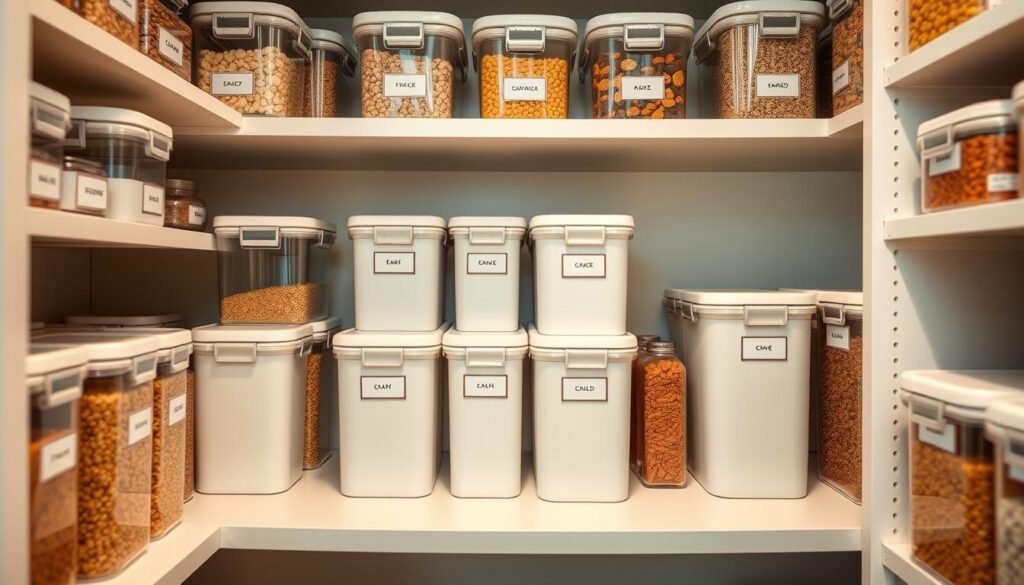
When it comes to pantry organization, the right containers can make all the difference. Decanting your pantry staples into uniform containers isn’t just about aesthetics—it’s a practical strategy that extends shelf life and makes inventory management easier.
Clear containers allow you to see at a glance when supplies are running low, simplifying grocery list creation and preventing overbuying. This is especially useful for dry goods like pasta, rice, and cereals.
Airtight jars and containers protect your food from moisture, pests, and premature staleness, potentially reducing food waste. Consider writing expiration dates on the bottom of containers with a dry-erase marker or attaching the original packaging information to the back.
Start small with decanting your most-used items rather than feeling pressured to transfer everything at once—you can gradually expand your system as you see the benefits. This approach will help you maintain a clutter-free pantry and make the most of your storage space.
Labels and Organization Systems That Last
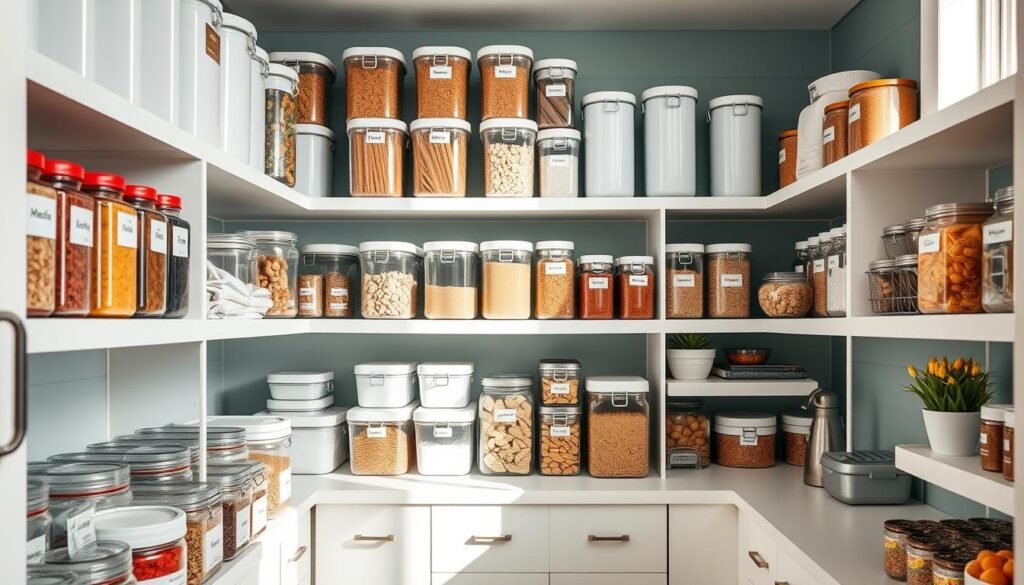
Labels are more than just tags; they’re the secret to a lasting organization system. Effective labeling transforms a temporarily organized pantry into one that stays functional over time.
To achieve this, consider your labeling aesthetic—handwritten for a personal touch, printed for consistency, or chalkboard for flexibility. Label not just containers but also zones, shelves, and bins so everyone knows where things belong.
Invest in durable, water-resistant labels for containers that may be handled with wet hands or stored in humid areas. Create a consistent labeling system that works for your family, whether it’s color-coded categories or simple text descriptions, to keep your pantry organized.
Hidden Pantry Ideas: Seamless Kitchen Integration
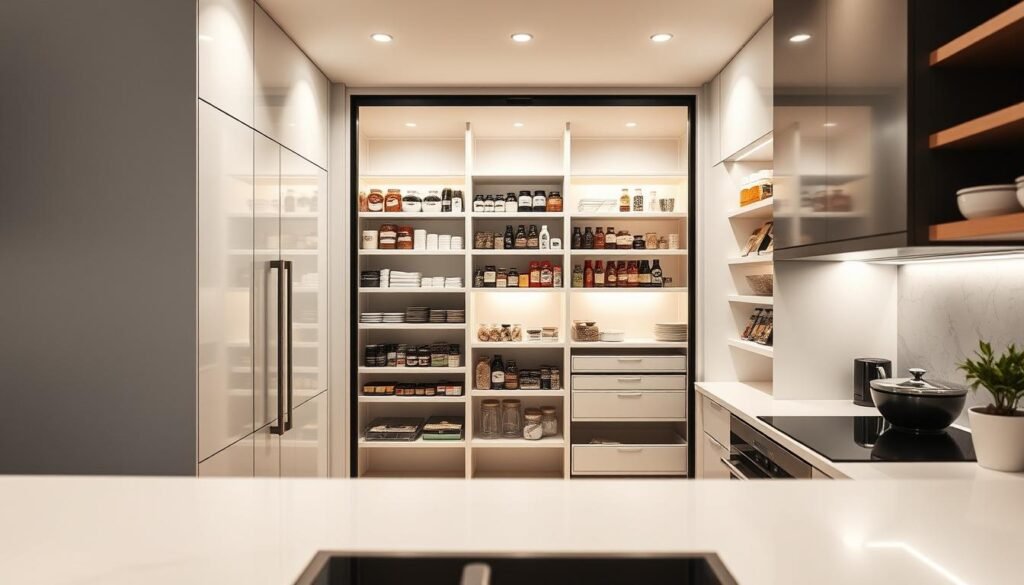
For those who value both form and function in their kitchen, hidden pantry solutions offer a perfect blend of aesthetics and practicality. You can achieve a clutter-free kitchen by incorporating a hidden pantry that seamlessly integrates with your existing cabinets and design.
One effective method is to disguise a walk-in pantry by covering the door with the same paneling as your kitchen cabinets and painting everything the same color, creating a cohesive design. Alternatively, consider using cabinet-fronted pantries, pocket doors, or sliding barn-style doors to conceal your pantry while adding architectural interest.
| Hidden Pantry Method | Description | Benefit |
|---|---|---|
| Cabinet-Fronted Pantry | Blends with surrounding cabinetry | Seamless integration |
| Pocket or Sliding Doors | Conceals pantry space | Adds architectural interest |
| Decorative Screen | Hides pantry behind a screen | Provides surprising storage |
By implementing these hidden pantry ideas, you can enjoy a more organized and visually appealing kitchen that meets your storage needs without compromising on style or design.
Butler’s Pantry: The Ultimate Organization Solution
A butler’s pantry is more than just a storage space; it’s a game-changer for kitchen organization. By providing a dedicated area for your kitchen essentials, you can keep your main kitchen clutter-free and focused on cooking.
Here are some benefits of having a butler’s pantry:
- Serves as a bridge between your kitchen and dining area, providing both storage and a staging area for entertaining.
- Can include secondary appliances like wine refrigerators or coffee stations to expand kitchen functionality.
- Allows for a mix of open shelving for display-worthy items and closed cabinets for less attractive necessities.
A countertop in your butler’s pantry creates valuable prep space for assembling platters or mixing drinks without cluttering your main kitchen. Consider incorporating task lighting for functionality and display lighting to highlight beautiful serveware or collections, making the most of your room.
Small Space Solutions: Pantry Organization for Tiny Kitchens
Even with limited space, you can create an organized pantry system. Smart storage and efficient use of space are essential in small kitchens.
To maximize your pantry’s potential, consider the following strategies:
- Portion snacks into bags and use food storage bins for easy access.
- Empty dry foods like cereal and pasta into clear plastic bins for easy recognition.
- Utilize an over-door wire rack to provide extra storage without cluttering shelves.
For tiny kitchens, think beyond the traditional pantry space. Consider repurposing a nearby closet or under-stairs area for additional storage. Maximize vertical space with tall, narrow shelving units that provide significant storage without a large footprint.
In small kitchens, multi-functional furniture like kitchen islands with storage or rolling carts can provide supplemental pantry space. Be selective about what you store in your pantry, prioritizing frequently used items.
Floor Organization: No More Cluttered Pantry Floors
The floor of your pantry is valuable storage real estate, don’t let it go to waste. To keep your pantry organized, it’s essential to make the most of every available space, including the floor. As I always say, “A cluttered floor is a sign of a cluttered mind.”Keeping your pantry floor clear is crucial for maintaining a sense of order and making the most of your storage space.
One effective way to utilize your pantry floor is by using sturdy bins, baskets, or rolling carts. These containers can hold items like bulk beverages, pet food, or small appliances, keeping them off the shelves and making them easily accessible. For instance, you can store waters or other drinks in water hyacinth bins, which not only keeps them organized but also adds a touch of elegance to your pantry.
To maintain a clutter-free pantry floor, consider implementing a “no loose items on the floor” rule. This simple habit can prevent clutter from building up and make cleaning much easier. You can also use clear plastic bins with wheels for floor storage that needs to be moved frequently, making it easier to clean the pantry floor.
By elevating your floor storage and reserving floor space for heavier items, you can create a more organized and functional pantry. As the saying goes, “A place for everything, and everything in its place.” By following these simple tips, you can say goodbye to cluttered pantry floors and hello to a more streamlined kitchen.
Maintaining Your Organized Pantry: Daily Habits
You don’t need a massive overhaul to keep your pantry organized; small daily habits are the answer. The secret to a perpetually organized space isn’t about dedicating hours to cleaning, but about cultivating habits that prevent clutter from building up.
Start by implementing a “one in, one out” rule for items in your pantry. When you buy a new spice, condiment, or specialty ingredient, check if there’s something that can be used up or discarded. This simple habit helps maintain a balanced amount of things in your pantry.
After grocery shopping, take a moment to properly place new items in their designated spots. This time-saving habit ensures that your pantry remains clutter-free. Additionally, regularly rotate your stock by placing newer food items behind older ones to ensure you’re using what you have before it expires.
Scheduling a quick weekly reset can also make a big difference. Spend 5-10 minutes returning misplaced items to their proper homes and wiping down any sticky shelves or containers. By incorporating these daily habits, you’ll be able to maintain your pantry with ease.
Conclusion: Transform Your Kitchen with Smart Pantry Solutions
Smart pantry solutions can revolutionize your cooking experience. A well-organized pantry isn’t just visually appealing; it’s a practical solution that transforms your daily cooking routine and reduces kitchen stress. To achieve this, remember that the perfect pantry system is tailored to your specific needs, space, and habits.
Start by focusing on one area of your kitchen pantry rather than feeling overwhelmed by a complete overhaul. View your pantry as an evolving system that can be adjusted as your family’s needs change over time. The time and resources invested in creating an organized pantry will pay dividends in reduced food waste and more efficient meal preparation.
By implementing solutions that work for you, you’ll create a more enjoyable cooking experience in your home. This thoughtful approach to pantry organization is a step towards a more streamlined and stress-free cooking environment.
FAQ
How do I choose the right storage containers for my pantry?
Select containers that are airtight, easy to clean, and fit your pantry’s style. Consider clear containers or canisters to keep contents visible, making it easier to find what you need.
What’s the best way to organize my pantry’s shelves?
Categorize items into zones, such as baking supplies or snacks, and assign a shelf or section for each. Use baskets or bins to corral small items and keep shelves tidy.
How can I maximize my pantry’s door space?
Utilize over-the-door storage racks, hooks, or shelves to hang items like spice racks, bags, or cleaning supplies, keeping them off the floor and out of the way.
Are pull-out shelves worth the investment?
Yes, pull-out shelves provide easy access to items stored in the back of your pantry, making it simpler to find what you need without having to dig through everything.
How often should I clean and maintain my pantry?
Schedule regular tidying sessions, ideally every 1-3 months, to keep your pantry organized and clutter-free. Set aside time to check expiration dates, wipe down shelves, and restock supplies.
Can I create a pantry in a small kitchen?
Absolutely! Consider compact storage solutions, like narrow shelves or baskets, and make the most of your kitchen’s vertical space to create a functional pantry.
How do I keep my pantry floor clear?
Use storage bins or baskets to corral items like snacks or cleaning supplies, and consider installing shelves or a pegboard to keep floor space clear.
What’s the benefit of labeling my pantry storage?
Labels help you quickly identify contents, making it easier to find what you need, and maintain your pantry’s organization system over time.
